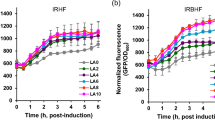Abstract
In the dilute acid pretreatment of lignocellulose, xylose substituted with α-1,2-methylglucuronate is released as methylglucuronoxylose (MeGAX), which cannot be fermented by biocatalysts currently used to produce biofuels and chemicals. Enterobacter asburiae JDR-1, isolated from colonized wood, efficiently fermented both MeGAX and xylose in acid hydrolysates of sweetgum xylan. Deletion of pflB and als genes in this bacterium modified the native mixed acid fermentation pathways to one for homolactate production. The resulting strain, Enterobacter asburiae L1, completely utilized both xylose and MeGAX in a dilute acid hydrolysate of sweetgum xylan and produced lactate approximating 100% of the theoretical maximum yield. Enterobacter asburiae JDR-1 offers a platform to develop efficient biocatalysts for production of fuels and chemicals from hemicellulose hydrolysates of hardwood and agricultural residues.


Similar content being viewed by others
References
Babson AL, Babson SR (1973) Kinetic colorimetric measurement of serum lactate dehydrogenase activity. Clin Chem 19:766–769
Bi C, Rice JD, Preston JF (2009) Complete fermentation of xylose and methylglucuronoxylose derived from methylglucuronoxylan by Enterobacter asburiae strain JDR-1. Appl Environ Microbiol 75:395–404
Dubois M, Gilles KA, Hamilton JK, Rebers PA, Smith F (1956) Colorimetric method for the determination of sugars and related substances. Anal Chem 28:350–356
Hurlbert JC, Preston JF (2001) Functional characterization of a novel xylanase from a corn strain of Erwinia chrysanthemi. J Bacteriol 183:2093–2100
Ingram LO, Conway T, Clark DP, Sewell GW, Preston JF (1987) Genetic engineering of ethanol production in Escherichia coli. Appl Environ Microbiol 53:2420–2425
Ingram LO, Aldrich HC, Borges ACC, Causey TB, Martinez A, Morales F, Saleh A, Underwood SA, Yomano LP, York SW, Zaldivar J, Zhou SD (1999) Enteric bacterial catalysts for fuel ethanol production. Biotechnol Prog 15:855–866
Jacobs A, Larsson PT, Dahlman O (2001) Distribution of uronic acids in xylans from various species of soft- and hardwood as determined by MALDI mass spectrometry. Biomacromolecules 2:979–990
Jantama K, Haupt MJ, Svoronos SA, Zhang XL, Moore JC, Shanmugam KT, Ingram LO (2008) Combining metabolic engineering and metabolic evolution to develop nonrecombinant strains of Escherichia coli C that produce succinate and malate. Biotechnol Bioeng 99:1140–1153
Kardosova A, Matulova M, Malovikova A (1998) (4-O-methyl-alpha-d-glucurono)-d-xylan from Rudbeckia fulgida, var. sullivantii (Boynton et Beadle). Carbohydr Res 308:99–105
Lee YY, Iyer P, Torget RW (1999) Dilute-acid hydrolysis of lignocellulosic biomass. Adv Biochem Eng Biotechnol 65:93–115
McMillan JD (1997) Bioethanol production: status and prospects. Renew Energy 10:295–302
Moat AG, Foster JW, Spector MP (2002) Microbial physiology, 4th edn. Wiley-Liss, New York
Preston JF, Hurlbert JC, Rice JD, Ragunathan A, St John FJ (2003) Microbial strategies for the depolymerization of glucuronoxylan: leads to biotechnological applications of endoxylanases. In: Mansfield SD, Sandler JN (eds) Applications of enzymes to lignocellulosics. American Chemical Society, Washington, DC, pp 191–210
Rodriguez M, Martinez EA, York SW, Zuobi-Hasona K, Ingram LO, Shanmugam KT and Preston JF (2001) Properties of the hemicellulose fractions of lignocellulosic biomass affecting bacterial ethanol production. Abstracts of the 101st national meetings of the American Society of Microbiology meetings in Orlando, FL, USA, p 535
Saha BC (2003) Hemicellulose bioconversion. J Ind Microbiol Biotechnol 30:279–291
Saha BC, Iten LB, Cotta MA, Wu YV (2005) Dilute acid pretreatment, enzymatic saccharification, and fermentation of rice hulls to ethanol. Biotechnol Prog 21:816–822
Shanmugam KT, Ingram LO (2008) Engineering biocatalysts for production of commodity chemicals. J Mol Microbiol Biotechnol 15:8–15
Taguchi H, Ohta T (1991) d-lactate dehydrogenase is a member of the d-isomer-specific 2-hydroxyacid dehydrogenase family—cloning, sequencing, and expression in Escherichia coli of the d-Lactate dehydrogenase gene of Lactobacillus plantarum. J Biol Chem 266:12588–12594
Timell TE (1964) Wood hemicelluloses. Adv Carbohydr Chem 19:247–302
Wood BE, Yomano LP, York SW, Ingram LO (2005) Development of industrial medium required elimination of the 2, 3-butanediol fermentation pathway to maintain ethanol yield in an ethanologenic strain of Klebsiella oxytoca. Biotechnol Prog 21:1366–1372
Zucker M, Hankin L (1970) Regulation of pectate lyase synthesis in Pseudomonas fluorescens and Erwinia carotovora. J Bacteriol 104:13–18
Acknowledgements
We thank Professor K.T. Shanmugam for helpful direction and discussions. This research was supported by U.S. Department of Energy grants DE FC36-99GO10476 and DE FC36-00GO10594. The Consortium for Plant Biotechnology Research Project GO12026-198 (DE FG36-02GO12026), and the Institute of Food and Agricultural Sciences, University of Florida Experiment Station, as CRIS Project MCS 3763.
Author information
Authors and Affiliations
Corresponding author
Rights and permissions
About this article
Cite this article
Bi, C., Zhang, X., Rice, J.D. et al. Genetic engineering of Enterobacter asburiae strain JDR-1 for efficient d(−) lactic acid production from hemicellulose hydrolysate. Biotechnol Lett 31, 1551–1557 (2009). https://doi.org/10.1007/s10529-009-0044-z
Received:
Revised:
Accepted:
Published:
Issue Date:
DOI: https://doi.org/10.1007/s10529-009-0044-z




